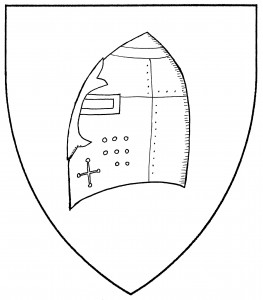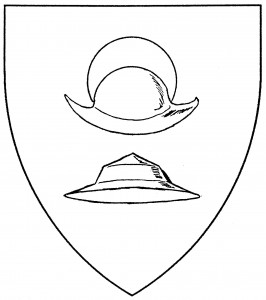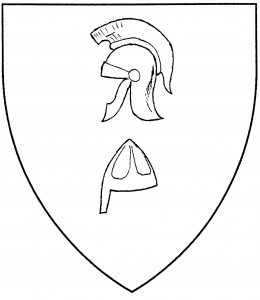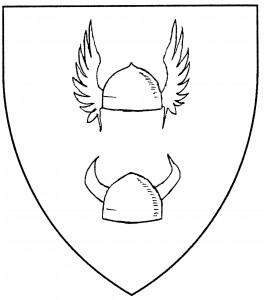A helm is a piece of armor designed to enclose and protect the head; its use as an heraldic charge dates from c.1285, in the arms of Daubeney [ANA2 475]. Throughout period, the type of helm would change, from the great helm in the canting arms of Helmshoven or Helmishofen, c.1340 [Zurich 358] to the barred tournament helm in the arms of Schaden, 1605 [Siebmacher 188]; but in each case, the charge was a “helm”, drawn according to the style of the time.
In Society armory, the “great helm” or “barrel helm” has been ruled the default, though it is sometimes explicitly blazoned. This is the form in the illustration. Other types of full helm (e.g., “sallet”, “spangenhelm”, “barbute”, &c) must be specified; the type carries no heraldic difference. If such a helm is blazoned “plumed”, it carries a single feather as a crest and favor; period helms, when used as charges, sometimes had other crests as well, as in the arms of Schaden, above.
There are also helms that do not enclose the head, but sit atop it. Of these, the “kettle helm” (also called a “chapel-de-fer” or “eisenhut”) is the most common: a broad-brimmed metal hat, more in use by the infantry than the chivalry. It’s a period charge, found in the arms of Sowys, c.1460 [RH] and of Spiegel, 1605 [Siebmacher 179].
There is also the “morion”, which in some texts is used as another term for the chapel-de-fer; it’s now accepted to mean a Spanish style of iron hat, with turned-up brim and a ridge-crest. This form of morion came into armorial use in the late 16th Century, as in the crest of Ramburgh, 1583 [Gwynn-Jones 104].
Of the helm variants unique to the Society, those blazoned a “winged helm” or “horned helm” are usually considered Viking helmets; these are metal caps with wings or horns, rather than full helms, though they may have eye-guards. (They have more in common with Victorian idealization than anything the Vikings actually wore. The horned helm, at least, is not permitted at this writing, pending period documentation.) The “Norman helm” is essentially a steel cap with a nasal. The “full-faced Saxon helmet” is the famous helm of Sutton Hoo. Helms of antiquity are not uncommon: Greek, Roman, and horned Corinthian helms have been registered.
The “Viking” helms, the Sutton Hoo helm, and the kettle helm are affronty by default; all other helms face dexter by default. For related charges, see hat, head (human’s), hood, skold.
The Shire of the Freelords of Stone Keep bears: Sable, a Greek helmet Or within a laurel wreath argent.
The Order of the Silver Morion of Mons Tonitrus bears: Sable, a morion and a bordure denticulada argent.
The Order of the Sable Helm, of the Barony of Bronzehelm, bears: A helm sable.
Mikhail Karten bears: Quarterly gules and checky azure and Or, a plumed great helm facing to sinister argent.
Olaf of Axar bears: Vert, three horned helmets argent.
Wilhelm von dem Bajwarishen Berg bears: Purpure, in pale two chapels de fer between as many flaunches Or, each flank charged with a spear purpure.
Gina Dragoni bears: Or, a full-faced Saxon helmet crested of a dragon purpure.



